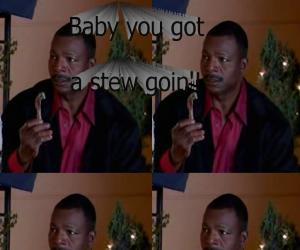Clothing protects the vulnerable
nude human body from the extremes of
weather, other features of our environment, and for safety reasons. Every article of clothing also carries a
cultural and social meaning. Human beings are the only creatures known to wear clothing, with the exception of pets clothed by their owners.
People also decorate their bodies with
makeup or
cosmetics,
perfume, and other
ornamentation; they also cut, dye, and arrange the hair of their heads,
faces, and bodies (see
hairstyle), and sometimes also mark their skin (by
tattoos,
scarifications, and
piercings). All these decorations contribute to the overall effect and message of clothing, but do not constitute clothing per se.
Articles carried rather than worn (such as
purses,
canes, and
umbrellas) are normally counted as
fashion accessories rather than as clothing.
Jewelry and
eyeglasses are usually counted as accessories as well, even though in common speech these items are described as being worn rather than carried.
The practical function of clothing is to protect the human body from dangers in the environment: weather (strong
sunlight, extreme
heat or
cold, and
precipitation, for example),
insects, noxious chemicals,
weapons, and contact with abrasive substances, and other hazards. Clothing can protect against many things that might injure the naked human body. In some cases clothing protects the environment from the clothing wearer as well (example:
medical scrubs).
Humans have shown extreme inventiveness in devising clothing solutions to practical problems and the distinction between clothing and other protective equipment is not always clear-cut. See, among others:
air conditioned clothing,
armor,
diving suit,
swimsuit,
bee-keeper's costume,
motorcycle leathers,
high-visibility clothing, and
protective clothing.
It may contain
original research or
unverifiable claims.
Tagged since August 2007. It may contain an
unpublished synthesis of published material that conveys ideas not
verifiable with the given sources.
Tagged since August 2007. It does not
cite any references or sources. Please help improve this article by citing
reliable sources.
Tagged since June 2007. Social status See also: undercover. In many regions of the world,
national costumes and styles in clothing and ornament declare membership in a certain village, caste, religion, etc. A Scotsman declares his clan with his
tartan. A
Muslim woman might wear a
hijab to express her religion. A male
Sikh may display his religious affiliation by wearing a
turban and other traditional clothing. A French peasant woman may identify her village with her cap or coif.
Clothes can also proclaim dissent from cultural norms and mainstream beliefs, as well as personal independence. In
19th-century Europe, artists and writers lived
la vie de Bohème and dressed to shock:
George Sand in men's clothing, female emancipationists in
bloomers, male artists in velvet waistcoats and gaudy neckcloths.
Bohemians,
beatniks,
hippies,
goths,
punks and
skinheads have continued the
counter-cultural) tradition in the
20th-century West. Now that
haute couture plagiarises
street fashion within a year or so, street fashion may have lost some of its power to shock, but it still motivates millions trying to look
hip and
cool.
Occupation Hindu women, once
married, wear
sindoor, a red powder, in the parting of their hair; if widowed, they abandon
sindoor and jewelry and wear simple white clothing. Men and women of the Western world may wear
wedding rings to indicate their marital status.
See also: Visual markers of marital status Marital status Clothing may signal an individual's receptiveness to sexual advances. Some garments signal lack of interest in advances; some garments and accessories indicate openness to flirtation. What constitutes modesty and allurement varies radically from culture to culture, within different contexts in the same culture, and over time as different
fashions rise and fall. Often, exposure of skin and hair is an availability signal; covering skin and hair signals unavailability. However, minute adjustments of "modesty" signals can subvert the surface meaning and convey a mixed message ("I'm nice but I like to flirt too").
The vocabulary of women's clothing is usually more developed than the vocabulary of men's clothing in this regard.
Examples of sexual signaling:
In
Amish communities, both men and women dress in plain garments that cover the body, without intricate details or patterns. Women also wear a prayer veil. Unmarried women wear black veils, married women wear white ones.
Many
Muslim women wear a head or body covering (see
hijab,
burqa or bourqa,
chador and
abaya) that proclaims their status as respectable and modest women.
Streetwalking
prostitutes in countries such as the United States where prostitution is illegal dress to advertise their status to potential customers, while avoiding anything that might constitute an unambiguous offer of sex for sale (which would increase their chances of being caught and convicted). They tend to wear current fashions in exaggerated form, bare a great deal of skin, and wear heavy makeup.
Sexual availability Religious clothing might be considered a special case of occupational clothing. Sometimes it is worn only during the performance of religious ceremonies. However, it may also be worn everyday as a marker for special religious status.
For example,
Jains wear unstitched cloth pieces when performing religious ceremonies. The unstitched cloth signifies unified and complete devotion to the task at hand, with no digression.
The cleanliness of religious dresses in Eastern Religions like
Hinduism,
Buddhism and
Jainism is of paramount importance, which indicates purity.
See also: Category:Religious vesture. Religious habits and special religious clothing Most sports and physical activities are practised wearing special clothing, for practical, comfort or safety reasons. Common
sportswear garments include
shorts,
T-shirts,
tennis shirts,
tracksuits, and
trainers. Specialised garments include
wet suits (for
swimming,
diving or
surfing) and
salopettes (for
skiing).
 Sport and activity
Sport and activity Common clothing materials include:
Less-common clothing materials include:
Reinforcing materials such as
wood,
bone,
plastic and
metal may be used in
fasteners or to stiffen garments.
Cloth, typically made of viscose
cotton,
flax,
wool,
hemp,
ramie,
silk,
lyocell, or
synthetic fibers such as
Polyester and
Nylon among many others.
Down for down-filled
parkas Fur Leather Denim Paper Jute Rubber PVC Recycled
PET Tyvek Rayon Hemp Bamboo Recycled or Recovered
Cotton Soy Other
Natural Fibers Clothing materials Clothing, once manufactured, suffers assault both from within and from without. The human body inside sheds skin cells and body oils, and exudes sweat, urine, and feces. From the outside, sun damage, damp, abrasion, dirt, and other indignities afflict the garment. Fleas and lice take up residence in clothing seams. Well-worn clothing, if not cleaned and refurbished, will smell, itch, look scruffy, and lose functionality (as when
buttons fall off and
zippers fail).
In some cases, people simply wear an item of clothing until it falls apart. Cleaning leather presents difficulties; one cannot wash bark cloth (tapa) without dissolving it. Owners may patch tears and rips, and brush off surface dirt, but old leather and bark clothing will always look
old.
But most clothing consists of cloth, and most cloth can be
laundered and mended (patching,
darning, but compare
felt).
Clothing maintenance Humans have developed many specialized methods for laundering, ranging from the earliest "pound clothes against rocks in running stream" to the latest in electronic
washing machines and
dry cleaning (dissolving dirt in
solvents other than water).
Many kinds of clothing are designed to be
ironed before they are worn to remove wrinkles. Most modern formal and semi-formal clothing is in this category (for example,
dress shirts and
suits). Ironed clothes are believed to look clean, fresh, and neat. However, much contemporary casual clothing is made of knit materials that do not readily wrinkle and so do not have to be ironed. Some clothing is
permanent press, meaning that it has been treated with a synthetic coating (such as
polytetrafluoroethylene) that suppresses wrinkles and creates a smooth appearance without ironing.
Once clothes have been laundered and possibly ironed, they are usually hung up on
clothes hangers or folded, to keep them fresh until they are worn. Clothes are
folded to allow them to be stored compactly, to prevent
creasing, to preserve creases or to present them in a more pleasing manner, for instance when they are put on sale in stores.
Many kinds of clothes are folded before they are put in
suitcases as preparation for travel. Other clothes, such as
suits, may be hung up in special garment bags, or rolled rather than folded. Many people use their clothing as packing material around fragile items that might otherwise break in transit.
Laundry, ironing, storage In past times,
mending was an art. A meticulous
tailor or
seamstress could mend rips with thread raveled from
hems and seam edges so skillfully that the darn was practically invisible. When the raw material — cloth — was worth more than labor, it made sense to expend labor in saving it. Today clothing is considered a consumable item. Mass-manufactured clothing is less expensive than the time it would take to repair it. Many people prefer to buy a new piece of clothing rather than to spend their time mending old clothes. But the thrifty still replace
zippers and
buttons and sew up ripped
hems.
Mending Used, no-longer-wearable clothing was once desirable raw material for
quilts,
rag rugs,
bandages, and many other household uses. It could also be recycled into
paper. Now it is usually thrown away. Used but still wearable clothing can be sold at
consignment shops,
flea markets,
online auction, or just donated to charity. Charities usually skim the best of the clothing to sell in their own
thrift stores and sell the rest to merchants, who bale it up and ship it to poor
Third World countries, where vendors bid for the bales and then make what profit they can selling used clothing.
The life cycle of clothing Western fashion has, to a certain extent, become international fashion, as Western media and styles penetrate all parts of the world. Very few parts of the world remain where people do not wear items of cheap, mass-produced Western clothing. Even people in poor countries can afford
used clothing from richer Western countries.
However, people may wear ethnic or
national dress on special occasions or if carrying out certain roles or occupations. For example, most Japanese women have adopted Western-style dress for daily wear, but will still wear silk
kimonos on special occasions. Items of Western dress may also appear worn or accessorized in distinctive, non-Western ways. A Tongan man may combine a used
T-shirt with a Tongan wrapped skirt, or
tupenu.
Western fashion, too, does not function monolithically. It comes in many varieties, from expensive
haute couture to
thrift store grunge.
Early 21st-century clothing styles For example: "
Catalogue" fashion, regional styles such as
preppy or
Western wear.
These fashions are often associated with fans of various musical styles.
See also: Gothic fashion, Hippie, Grunge, Hip hop music, and Fetish clothing Clothing of Europe and Russia Clothing in the Americas
- South American fashion
United States mainstream fashion
- United States alternative fashion
Clothing in Asia
Clothing in Africa
Clothing in Oceania
Islamic clothing Origin and history of clothing
As technologies change, so will clothing. Many people, including futurologists have extrapolated current trends and made the following predictions:
Man-made fibers such as nylon, polyester, terylene, terycot, lycra, and Gore-Tex already account for much of the clothing market. Many more types of fibers will certainly be developed. Clothing industry
Clothing terminology
Nudity
Costume
Clothes valet
Clothes hanger
 Emphasized relationship of main table
Emphasized relationship of main table Formation of the Jewish Brigade
Formation of the Jewish Brigade
 Complete Formula One results
Complete Formula One results
 Indices
Indices Legend
Legend Illustration to The Garden of Paradise
Illustration to The Garden of Paradise Illustration to
Illustration to  Discography
Discography Biography
Biography Football career
Football career
 Sport and activity
Sport and activity General APIs
General APIs History
History Architecture
Architecture Theatre career
Theatre career